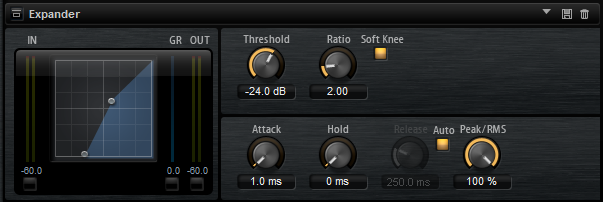Expander
The Expander reduces the output level in relation to the input level for signals below the set threshold. This is useful to enhance the dynamic range or reduce the noise in quiet passages.

The graphical control to the left shows the expansion curve. You can edit the Threshold and Ratio values with the handles of this control. The input and output meters indicate the level before and after the expansion. The Gain Reduction meter indicates the current attenuation of the level.
- Threshold
-
Sets the threshold. Sounds that are softer than the threshold are reduced in gain. Sounds above the threshold remain unaffected by the process.
- Ratio
-
Sets the amount of gain reduction for sounds that are softer than the threshold. The higher the ratio, the more the output is lowered. For example, if the ratio is set to 2:1 and the amplitude of the sound is 4 dB below the threshold, the output is lowered by 2 dB. If the amplitude is 8 dB below the threshold, the output is lowered by 4 dB.
- Soft Knee
-
-
If this button is deactivated, signals above the threshold are compressed instantly based on the set ratio.
-
If this button is activated, the onset of the expansion is more gradual, producing a less drastic result.
-
- Attack
-
Determines how fast the Expander reduces the gain when the sound falls below the set threshold. The longer the attack time, the longer it takes to reduce the gain.
- Hold
-
Sets the time period during which the expansion is applied after the sound falls below the set threshold.
- Release
-
Determines how fast the Expander effect raises the gain after the sound exceeds the set threshold. The longer the release time, the longer it takes to raise the gain.
NoteThis parameter is not available when the Auto Release button is activated.
- Auto
-
Activate this to set the release time automatically. The Expander analyzes the input sound continuously to find the optimal setting.
- Peak/RMS
-
Determines whether the input signal is analyzed based on Peak or RMS values or a mixture of both. With a setting of 0%, the expander uses Peak sensing only, and at 100%, RMS sensing only. Peak means that the expander senses the peak level of the sound. RMS means that the expander senses the average power of the sound. Peak sensing responds faster than RMS sensing. Typically, Peak sensing is used for transient sounds and RMS sensing for sustained sounds.
- Live
-
If this button is activated, the look-ahead feature of the effect is disengaged. Look-ahead results in more accurate processing, but adds a certain amount of latency as a trade-off. If Live mode is activated, there is no latency, which is better for live processing.